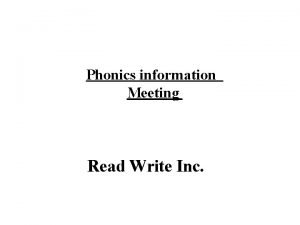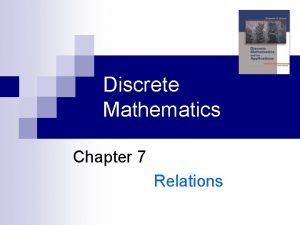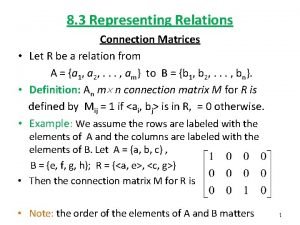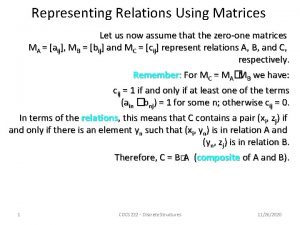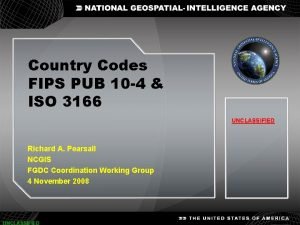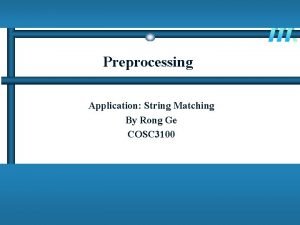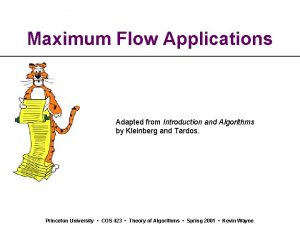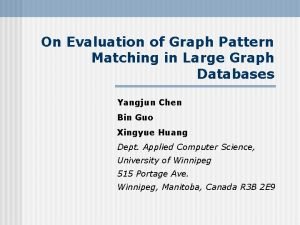DS GR 14 Graph Matching Input 2 digraphs










- Slides: 10

DS. GR. 14 Graph Matching Input: 2 digraphs G 1 = (V 1, E 1), G 2 = (V 2, E 2) Questions to ask: 1. Are G 1 and G 2 isomorphic? 2. Is G 1 isomorphic to a subgraph of G 2? 3. How similar is G 1 to G 2? 4. How similar is G 1 to the most similar subgraph of G 2?

DS. GR. 15 Isomorphism for Digraphs G 1 is isomorphic to G 2 if there is a 1 -1, onto mapping h: V 1 V 2 such that ( vi, vj ) E 1 iff ( h(vi), h(vj) ) E 2 G 1 1 G 2 2 a 3 4 b c 5 d e Find an isomorphism h: {1, 2, 3, 4, 5} {a, b, c, d, e}. Check that the condition holds for every edge.

DS. GR. 16 Subgraph Isomorphism for Digraphs G 1 is isomorphic to a subgraph of G 2 if there is a 1 -1 mapping h: V 1 V 2 such that ( vi, vj ) E 1 ( h(vi), h(vj) ) E 2 G 1 1 G 2 2 3 a b c d Isomorphism and subgraph isomorphism are defined similarly for undirected graphs. In this case, when (vi, vj) E 1, either (vi, vj) or (vj, vi) can be listed in E 2, since they are equivalent and both mean {vi, vj}.

DS. GR. 17 Similar Digraphs Sometimes two graphs are close to isomorphic, but have a few “errors. " Let h(1)=b, h(2)=e, h(3)=c, h(4)=a, h(5) = d. G 1 1 G 2 2 a 3 4 (1, 2) (2, 1) X (4, 5) (2, 5) (3, 2) (3, 4) c 5 (b, e) (e, b) (c, b) (a, d) (e, d) X (c, a) b d e The mapping h has 2 errors. (c, b) G 2, but (3, 1) G 1 (3, 2) G 1, but (c, e) G 2

Error of a Mapping DS. GR. 18 Intuitively, the error of mapping h tells us - how many edges of G 1 have no corresponding edge in G 2 and - how many edges of G 2 have no corresponding edge in G 1. Let G 1=(V 1, E 1) and G 2=(V 2, E 2), and let h: V 1 V 2 be a 1 -1, onto mapping. forward error EF(h) = |{(vi, vj) E 1 | (h(vi), h(vj)) E 2}| edge in E 1 corresponding edge not in E 2 -1 -1 backward EB(h) = |{(vi, vj) E 2 | (h (vi), h (vj)) E 1}| error edge in E 2 corresponding edge not in E 1 total error Error(h) = EF(h) + EB(h) relational distance GD(G 1, G 2) = min Error(h) for all 1 -1, onto h: V 1 V 2

DS. GR. 19 Variations of Relational Distance 1. normalized relational distance: Divide by the sum of the number of edges in E 1 and those in E 2. 2. undirected graphs: Just modify the definitions of EF and EB to accommodate. 3. one way mappings: h is 1 -1, but need not be onto Only the forward error EF is used. 4. labeled graphs: When nodes and edges can have labels, each node should be mapped to a node with the same label, and each edge should be mapped to an edge with the same label.

DS. GR. 20 Graph Matching Algorithms 1. * 2. * 3. 4. graph isomorphism subgraph isomorphism relational distance attributed relational distance (uses labels) Subgraph Isomorphism Given model graph M = (VM, EM) data graph D = (VD, ED) Find 1 -1 mapping h: VM VD satisfying (vi, vj) EM ((h(vi), h(vj)) ED.

DS. GR. 21 Method: Backtracking Tree Search D M 1 a 2 b c e 3 d root 1, b 1, a 2, b X 2, c. . . X 3, d 3, c X X 1, c 2, a . . . 1, d . . . 2, c 3, e 3, a 3, d X X YES! 1, e. . .

DS. GR. 22 Treesearch for Subgraph Isomorphism in Digraphs procedure Treesearch(VM, VD, EM, ED, h) { v = first(VM); for each w VD { h’ = h {(v, w)}; //add to set OK = true; (with vi < vj for each edge (vi, vj) in EM undirected graphs) if one of vi or vj is v and the other has been assigned a value in h’ if ( (h’(vi), h’(vj)) is NOT in ED ) {OK = false; break; }; if OK { VM’ = VM – v; //remove from set VD’ = VD – w’ if isempty(VM’) output(h’); else Treesearch(VM’, VD’, EM, ED, h’) } } }

Branch-and-Bound Tree Search DS. GR. 23 Keep track of the least-error mapping. D M 1 a 2 b d 3 map_err = 0 bound_err = 99999 root map_err = 0 1, b 1, a map_err = 1 2, b c . . . map_err = 0 2, c X 2, d X 3, c map_err = 1 bound_err = 1 mapping = {(1, a)(2, b)(3, c)} 2, a 2, c X X X 3, a 2, d 3, c map_err = 0; bound_err = 1 mapping = {(1, b)(2, d)(3, c)}


